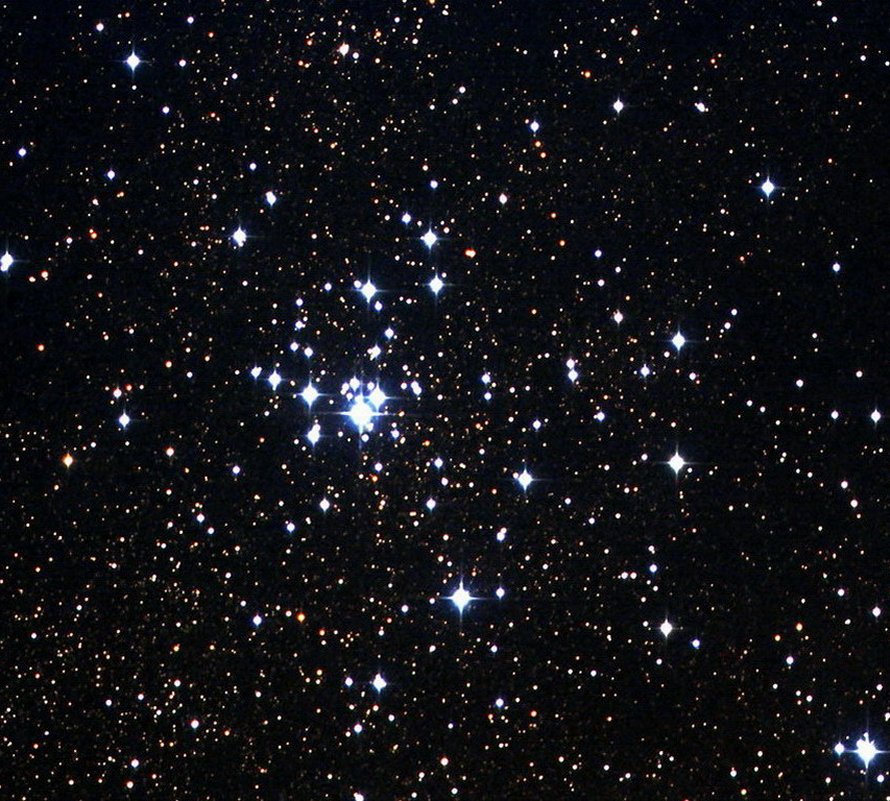M21 (NGC 6531)
Messier 21 (NGC 6531) is an open cluster located in the constellation Sagittarius, in the Sagittarius Arm of the Milky Way Galaxy in the Local Group of galaxies. M21 is 3900 light years away from Earth.
M21 is best viewed during late summer, is magnitude 6.5, and can be viewed with binoculars. M21 is 14' in apparent size. For reference, the full moon is 30'.
Observing difficulty: Easy
- Name:
- Type:
- open cluster
- Constellation:
- Sagittarius
- NGC or IC:
- NGC 6531
- Magnitude:
- 6.5
- Viewing:
- binoculars
- Size:
- 14'
- Distance (light years):
- 3900 LY
- RA:
- 18h 4.6m
- Dec:
- -22 30'
- Season:
- late summer
- Milky Way location:
- Sagittarius Arm
- Galaxy group:
- Local Group
- Messier Marathon #:
- 96
* The naked eye can see up to magnitude ~7-8 objects under ideal dark sky conditions.
A Compact Assembly of Youthful Stars
Messier 21 (M21), located in the rich star fields of the constellation Sagittarius, is an open cluster that boasts an impressive collection of young, hot stars. Though it is less celebrated than its neighbor, the Trifid Nebula (M20), M21 remains a fascinating target for amateur astronomers. In this article, we explore M21's discovery, its physical and stellar characteristics, its magnitude, and offer guidance on how to locate and observe it.
Discovery and Observation
M21 was first cataloged by French astronomer Charles Messier on June 5, 1764. This open star cluster is situated approximately 4,250 light-years away from Earth. Despite its distance, M21 presents a pleasant sight to astronomers who have the opportunity to peer at it through a telescope.
Physical Characteristics and Magnitude
Spanning about 13 light-years, M21 is a relatively compact open cluster, comprising around 57 stars. Its most luminous members are of spectral type B. The combined light of the cluster stars gives M21 an apparent magnitude of 6.5. As such, while M21 is not visible to the naked eye, it can be spotted using binoculars or a small telescope, where it appears as a somewhat scattered, loose collection of stars.
Stellar Composition
M21 is striking for its relatively young age - a mere 4.6 million years. This youthfulness is evident in the predominance of young, hot, blue stars, which constitute the majority of the cluster's population. The presence of these stars offers a glimpse into the early stages of stellar evolution, providing invaluable data for scientists studying this phase of a star's life cycle.
Astronomical Significance
M21's relatively young age, along with its compact size and significant number of young, hot stars, makes it a worthy subject of study for astronomers interested in the dynamics of star formation and early stellar evolution. By studying clusters like M21, astronomers can gain insight into the processes through which such stellar assemblies form and evolve over time.
Finding and Viewing M21
Located in the constellation Sagittarius, M21 is best visible in the summer months in the Northern Hemisphere. It's conveniently situated near the Trifid Nebula (M20), forming a striking pair that can be viewed in the same field of view in a telescope. Through binoculars or a small telescope, M21 appears as a compact, diffuse patch of light. Observers using larger telescopes can resolve individual stars, appreciating their concentration and collective glow.



